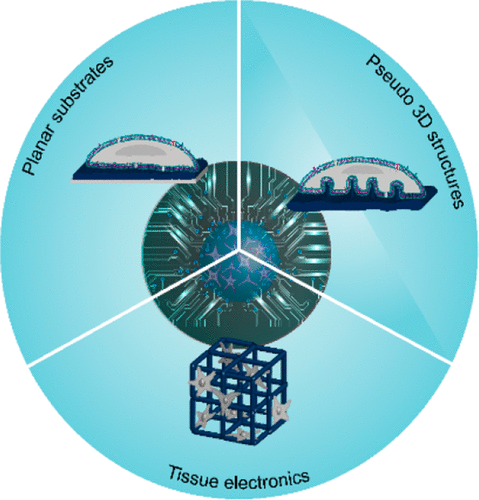当前位置:
X-MOL 学术
›
Chem. Rev.
›
论文详情
Our official English website, www.x-mol.net, welcomes your
feedback! (Note: you will need to create a separate account there.)
Advances in Cell-Conductive Polymer Biointerfaces and Role of the Plasma Membrane
Chemical Reviews ( IF 51.4 ) Pub Date : 2021-09-28 , DOI: 10.1021/acs.chemrev.1c00363 Anna Mariano 1 , Claudia Lubrano 1, 2 , Ugo Bruno 1, 2 , Chiara Ausilio 1 , Nikita Bhupesh Dinger 1, 2 , Francesca Santoro 1
Chemical Reviews ( IF 51.4 ) Pub Date : 2021-09-28 , DOI: 10.1021/acs.chemrev.1c00363 Anna Mariano 1 , Claudia Lubrano 1, 2 , Ugo Bruno 1, 2 , Chiara Ausilio 1 , Nikita Bhupesh Dinger 1, 2 , Francesca Santoro 1
Affiliation

|
The plasma membrane (PM) is often described as a wall, a physical barrier separating the cell cytoplasm from the extracellular matrix (ECM). Yet, this wall is a highly dynamic structure that can stretch, bend, and bud, allowing cells to respond and adapt to their surrounding environment. Inspired by shapes and geometries found in the biological world and exploiting the intrinsic properties of conductive polymers (CPs), several biomimetic strategies based on substrate dimensionality have been tailored in order to optimize the cell–chip coupling. Furthermore, device biofunctionalization through the use of ECM proteins or lipid bilayers have proven successful approaches to further maximize interfacial interactions. As the bio-electronic field aims at narrowing the gap between the electronic and the biological world, the possibility of effectively disguising conductive materials to “trick” cells to recognize artificial devices as part of their biological environment is a promising approach on the road to the seamless platform integration with cells.
中文翻译:

细胞导电聚合物生物界面的进展和质膜的作用
质膜 (PM) 通常被描述为一堵墙,是将细胞质与细胞外基质 (ECM) 分开的物理屏障。然而,这堵墙是一种高度动态的结构,可以拉伸、弯曲和发芽,使细胞能够响应和适应周围环境。受生物世界中发现的形状和几何形状的启发,并利用导电聚合物(CP)的固有特性,定制了几种基于基底维度的仿生策略,以优化细胞-芯片耦合。此外,通过使用 ECM 蛋白或脂质双层的装置生物功能化已被证明是进一步最大化界面相互作用的成功方法。由于生物电子领域的目标是缩小电子世界和生物世界之间的差距,因此有效地伪装导电材料以“欺骗”细胞将人造设备识别为其生物环境的一部分的可能性是通往生物电子之路的一种有前景的方法。与细胞的无缝平台集成。
更新日期:2021-09-28
中文翻译:

细胞导电聚合物生物界面的进展和质膜的作用
质膜 (PM) 通常被描述为一堵墙,是将细胞质与细胞外基质 (ECM) 分开的物理屏障。然而,这堵墙是一种高度动态的结构,可以拉伸、弯曲和发芽,使细胞能够响应和适应周围环境。受生物世界中发现的形状和几何形状的启发,并利用导电聚合物(CP)的固有特性,定制了几种基于基底维度的仿生策略,以优化细胞-芯片耦合。此外,通过使用 ECM 蛋白或脂质双层的装置生物功能化已被证明是进一步最大化界面相互作用的成功方法。由于生物电子领域的目标是缩小电子世界和生物世界之间的差距,因此有效地伪装导电材料以“欺骗”细胞将人造设备识别为其生物环境的一部分的可能性是通往生物电子之路的一种有前景的方法。与细胞的无缝平台集成。











































 京公网安备 11010802027423号
京公网安备 11010802027423号